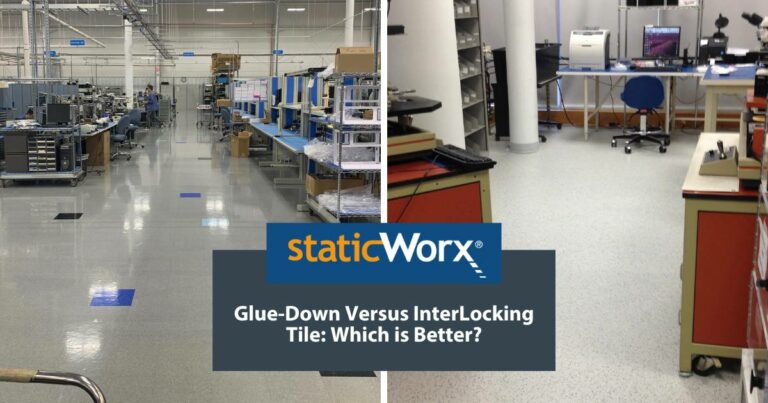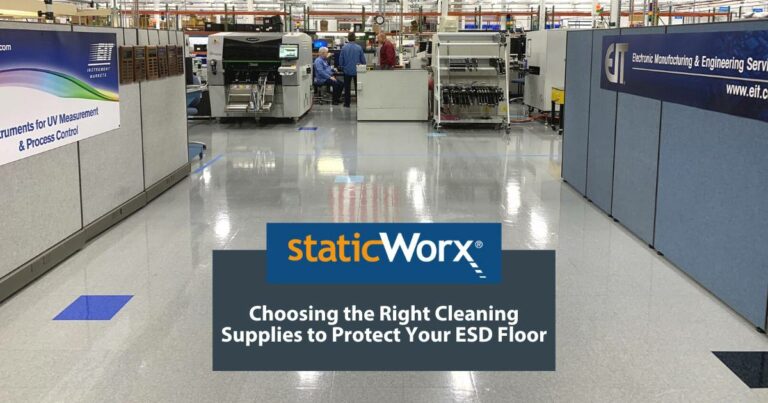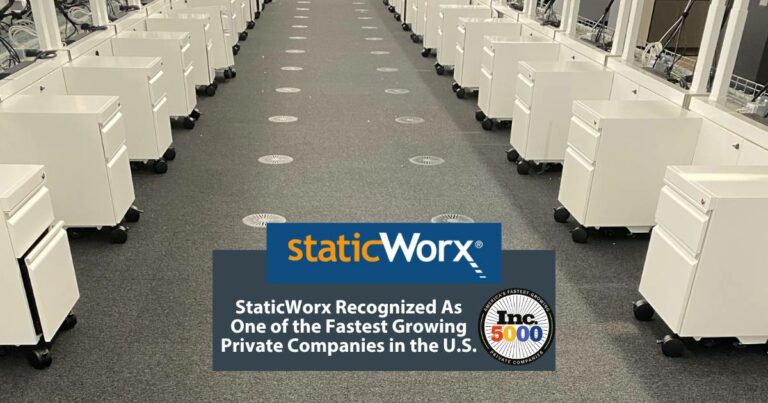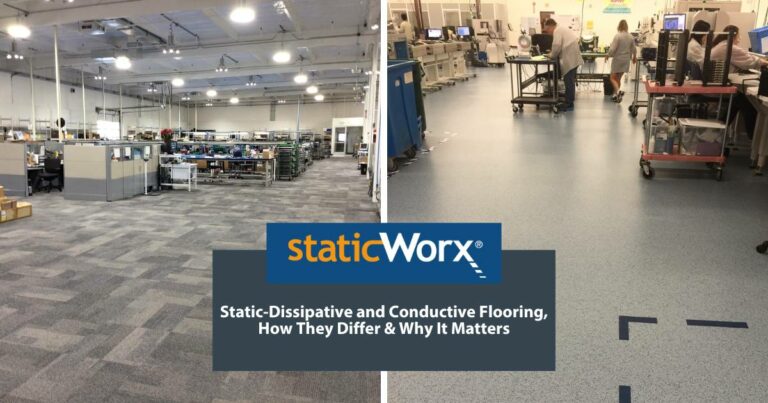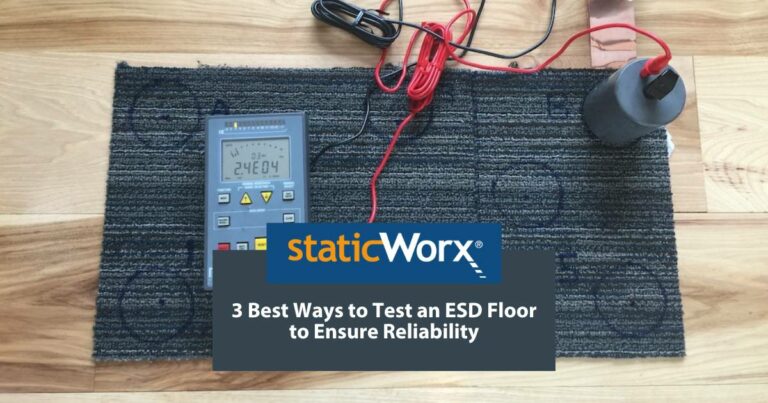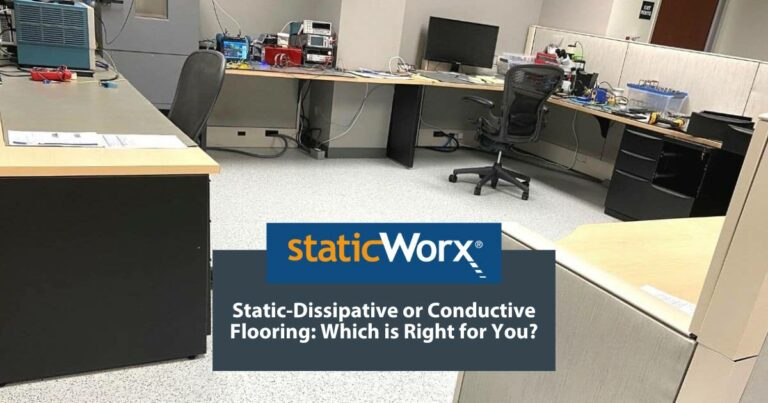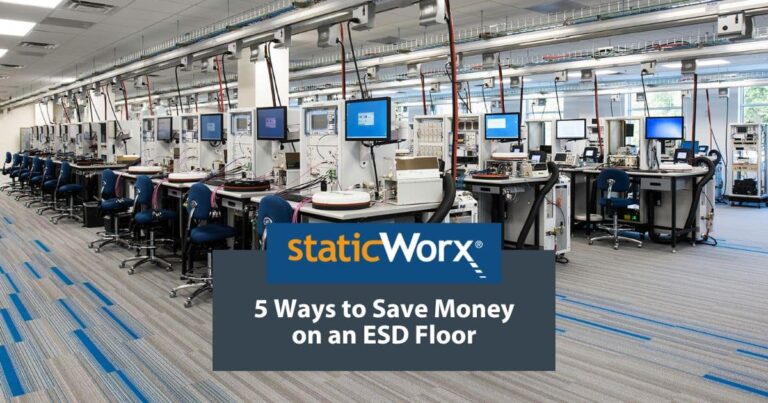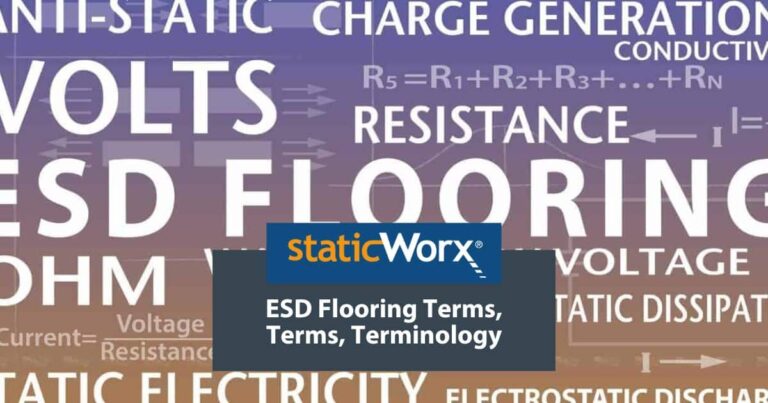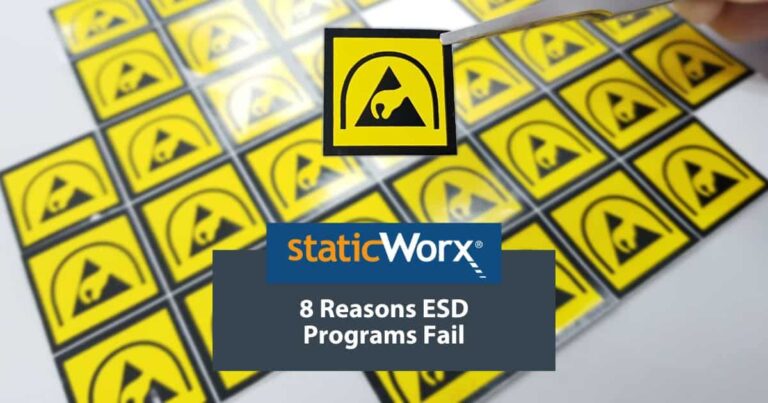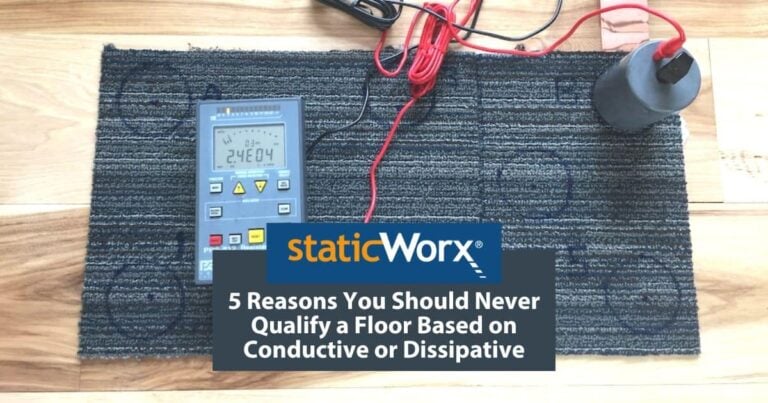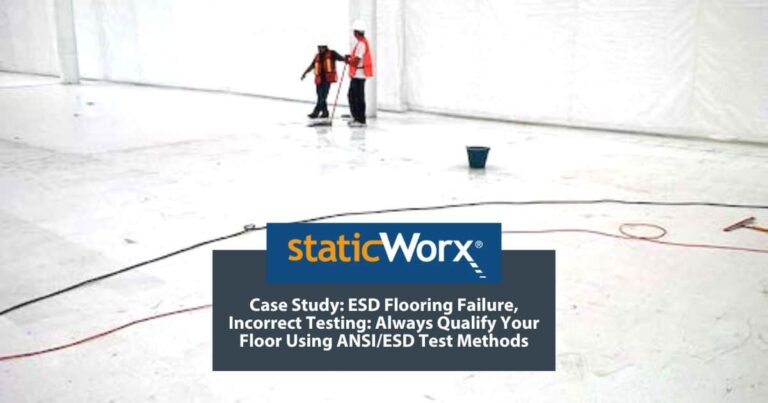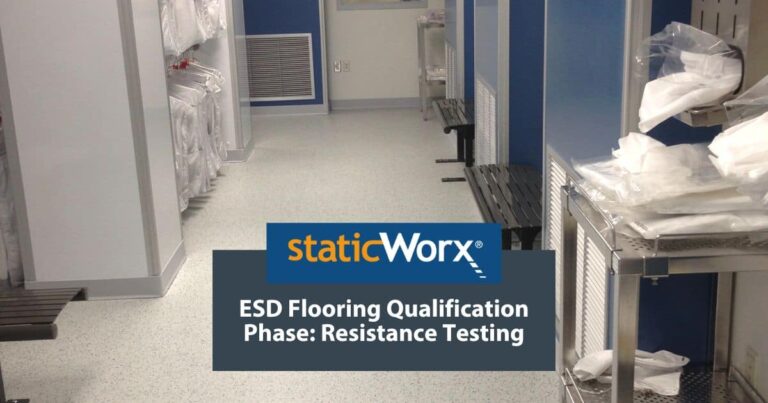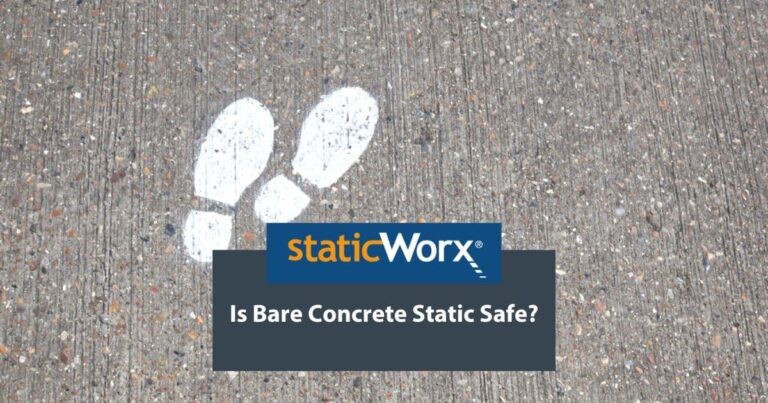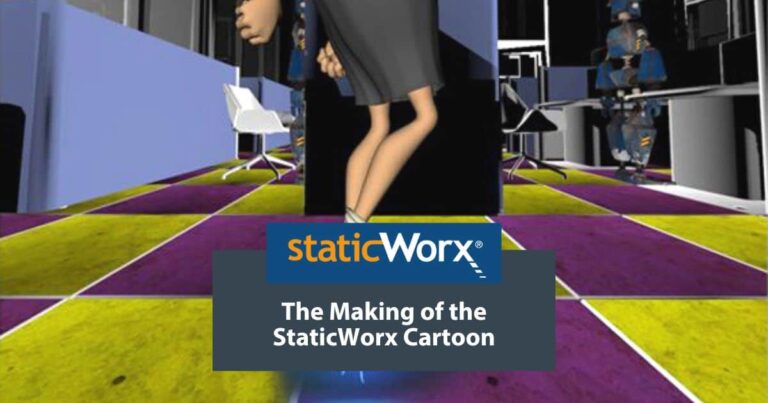Learn the differences between ESD solid vinyl tile and interlocking ESD tile. The post compares specs, installation, maintenance and intangibles.

Installing ESD Flooring Without Adhesives and Downtime
10 min read, 5 min videos
This article – written by StaticWorx Founder and President, Dave Long – was originally published in U.S. Tech magazine, June 2021
EMS companies often handle devices that are extremely sensitive to static electricity. If the manufacturer does not have a static-control program in place, it can be tricky to implement one without shutting down the facility for days.
Space may be tight, personnel and equipment crowding the shop floor, and operations managers have to balance the enormous cost of lost productivity against the need to protect new parts and devices.
A major part of any ESD control program is getting the proper flooring in place. Foreign objects and debris (FOD) can affect the reliability of parts and assemblies. How can one replace a floor without generating any debris? What if the subfloor is in such poor condition that it prevents a standard installation? What will make up for the lost time?
Space may be tight, personnel and equipment crowding the shop floor, and operations managers have to balance the enormous cost of lost productivity against the need to protect new parts and devices.
A major part of any ESD control program is getting the proper flooring in place. Foreign objects and debris (FOD) can affect the reliability of parts and assemblies. How can one replace a floor without generating any debris? What if the subfloor is in such poor condition that it prevents a standard installation? What will make up for the lost time?
Failing Floors Fail Again
AMC, a manufacturer of motion control equipment located in Ventura County, California, had a fire in its building, with extensive smoke and water damage. Repairs included installation of a conductive ESD vinyl tile floor. The timing was fortuitous: their 30-year-old vinyl composition tile (VCT) had curled, pulling loose from the concrete substrate. By replacing the floors in their manufacturing and stockroom areas, they could also change the layout of their SMT operation.
They purchased the ESD vinyl tiles from a distributor and hired local flooring contractors for the installation. Because the old VCT was lifting, it had to be removed. The installer determined the root cause of the flooring failure to be a combination of vapor permeation from moisture below the concrete and chemical residues from the bond breakers used to erect the original concrete walls, part of a process known as tilt-up construction.
The solution was to shot-blast the concrete and install a vapor-resistant topical barrier on its surface. Shot-blasting generates FOD, so the areas had to be cordoned off with plastic sheeting, with positive-pressure air handlers to filter the air.
The installers blasted the concrete, applied a vapor barrier, installed conductive epoxy adhesive over the barrier, and set the tiles in place. The installation looked great. The seams were tight, and the white tile added brightness to the building.
A few months later, however, the new tiles began to dimple. Lifting them revealed moisture under the floor, confirming that the vapor barrier was not functioning properly. The installation was a failure.
The good news: AMC only covered 20 percent of its facility with the floor. The bad news: the company committed to installing new flooring and there was no confidence in using glue-down floor tiles a second time.
Dissecting the Problem
StaticWorx visited the facility in May 2019. The most formidable challenge was the underlying condition of AMC’s concrete substrate. The building had been constructed before California building code required the placement of a plastic vapor retarder below the concrete.
A plastic vapor retarder helps prevent the permeation of water vapor through the slab. Without a vapor retarder, water vapor migrates through concrete and becomes alkaline. If the floor installed over the concrete cannot breathe, the alkaline vapors degrade the adhesive, and the floor fails.
In AMC’s case, the problem was exacerbated by the bond breakers sprayed on their concrete slab. Bond breakers leave a residue in the concrete that negatively impacts adhesion of epoxy and tile floors. Combined with the lack of a vapor retarder, this is a recipe for flooring disaster.
These conditions left the building owner with few options. AMC had already tried to eliminate the root cause by shot-blasting their concrete and installing a topical vapor barrier. This process is time consuming and expensive. Depending on physical location and problem severity, the installation of a topical vapor barrier can run anywhere from $3 to $7 per square foot.
Circumstances prevented a standard glue-down ESD flooring installation. AMC management already knew the subfloor conditions would eventually degrade any glue-down ESD floor or epoxy coating. What AMC needed was a free-floating floor that would meet the stringent ESD requirements in ANSI/ESD S20.20 while projecting their facility’s best-in-class appearance.
GroundLock Interlocking Tile
GroundLock Extreme interlocking tile met all the requirements. AMC appreciated the ruggedness of the tile, its chemical resistance and visually appealing, low-maintenance surface, which never needs wax.
As the tiles interlock, GroundLock installations require no adhesive. This adhesive-free installation allowed AMC to maintain full operations throughout the project. Expansion, contraction and doming of tiles, due to minor shifts in subfloor temperature, are the biggest obstacles to a perfect glue-free installation.
With GroundLock, two layers of fiberglass, sandwiched between the top and bottom layers of each tile, ensure dimensional stability. A completely automated manufacturing process — from the moment resins are extracted from rail cars all the way through packaging and palletization — guarantees precision interlocking and consistent tile thickness.
These precision joints enable workers of all skill levels to install GroundLock quickly, despite uneven subfloors, tight spaces or time constraints. The only necessary installation tools are a chalk line, dead-blow hammer and a bullet cutter. The installation process is simple enough that many users install GroundLock tiles themselves, over surfaces ranging from old carpet to raised access panels to failing VCT and epoxy floors.
Once placed, GroundLock tiles can handle any level of traffic, including forklifts and scissor lifts. Heavy SMT lines are easily moved and relocated, and carts and trolleys roll as easily as they would over bare concrete. As GroundLock requires no adhesives, vapor permeation has no effect on the integrity of the installation. The installation crew at AMC installed about 30,000 ft2 at a rate of almost 1,000 ft2 per installer per day — and turned the floor over on schedule for equipment relocation.
GroundLock Extreme interlocking tile met all the requirements. AMC appreciated the ruggedness of the tile, its chemical resistance and visually appealing, low-maintenance surface, which never needs wax.
As the tiles interlock, GroundLock installations require no adhesive. This adhesive-free installation allowed AMC to maintain full operations throughout the project. Expansion, contraction and doming of tiles, due to minor shifts in subfloor temperature, are the biggest obstacles to a perfect glue-free installation.
With GroundLock, two layers of fiberglass, sandwiched between the top and bottom layers of each tile, ensure dimensional stability. A completely automated manufacturing process — from the moment resins are extracted from rail cars all the way through packaging and palletization — guarantees precision interlocking and consistent tile thickness.
These precision joints enable workers of all skill levels to install GroundLock quickly, despite uneven subfloors, tight spaces or time constraints. The only necessary installation tools are a chalk line, dead-blow hammer and a bullet cutter. The installation process is simple enough that many users install GroundLock tiles themselves, over surfaces ranging from old carpet to raised access panels to failing VCT and epoxy floors.
Once placed, GroundLock tiles can handle any level of traffic, including forklifts and scissor lifts. Heavy SMT lines are easily moved and relocated, and carts and trolleys roll as easily as they would over bare concrete. As GroundLock requires no adhesives, vapor permeation has no effect on the integrity of the installation. The installation crew at AMC installed about 30,000 ft2 at a rate of almost 1,000 ft2 per installer per day — and turned the floor over on schedule for equipment relocation.
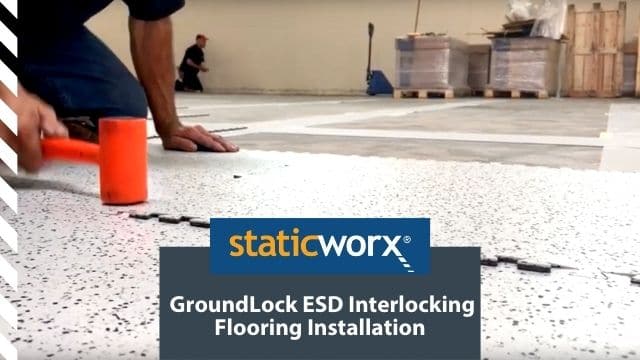

Not Just for SMT
This past year, StaticWorx was approached by FW Chase, a company that builds engineered environments and cleanrooms, to provide flooring for Macom, a semiconductor fabricator in Lowell, Massachusetts.
Macom wanted to transform its ISO Class-3 wafer fab facility into an ESD-protected environment without shutting down the cleanroom. With the same tools used on the AMC job, the Chase flooring team installed almost 15,000 ft2 of flooring directly over the vinyl floor in the existing cleanroom.
Despite the uneven surface of the old floor, there was no visual telegraphing through the GroundLock tiles. Like AMC, Macom put GroundLock through a rigorous evaluation for compliance to ESD standard ANSI/ESD S20.20 as well as evaluating the tile for FOD generation, ruggedness, flatness and appearance. Because of the tight space constraints in a cleanroom, the Chase installation team had to carefully coordinate the placement of tiles with ongoing cleanroom traffic.
They were also required to adhere to all the same cleanroom protocols as the Macom personnel. The project was a complete success, with Macom deciding to duplicate the installation at another location.


About StaticWorx, Inc
All StaticWorx posts are written by our technical team and based on industry standards and specifications, test data, independent lab reports and other verifiable data. We provide ESD training and offer CEU credits to architects. If you’re interested in an ESD training session or our architects’ ESD workshop, give us a call: 617-923-2000.
Get in Touch
The form below will help us better understand your needs and get you as quickly as possible to the right person. We look forward to helping you solve your static problem!
You can expect a response within 24 hours. For faster service, please give us a call: 617-923-2000
"*" indicates required fields
Visit our privacy policy to find out how we process data.
More Blog Posts
To maintain performance, ESD floors require specially formulated products. We offer tips on what to consider when choosing cleaning supplies.
Static-dissipative floors transport harmful static charges to ground. Dissipative is also a term for flooring with a specific, measurable electrical resistance.
StaticWorx recognized as one of the fastest growing private companies in the U.S. 2023 marks StaticWorx fourth appearance on Inc. 5000 list.
Conductive and dissipative flooring protect electronics by transporting charges to ground, conductive at a quicker rate, dissipative slower & more controlled.
We explain the 3 main ways to test an ESD floor: Electrical resistance; body voltage & ESD audits, with advantages and reasons for each.
Three critical factors—application, industry standards & footwear—help you choose the best ESD floor, while ensuring the safety & efficiency of your operations.
StaticWorx Founder and President Dave Long shares three of his recommended reads: Quit, How to Change, and The Goal.
There are leadership qualities StaticWorx strives to embody every day, with every product, throughout each project.
No matter how you slice and dice a project, an ESD floor is a major investment. This blog post examines five ways to keep undue costs down.
What’s the difference between static control and static resistant? Or anti-static flooring? Find out more in our blog post.
A well-designed, comprehensive, fully realized program is a must for manufacturers serious about ESD control. Learn why ESD programs fail.
ESD Floors should never be specified based on the descriptive terms conductive or static dissipative. Always base ESD specs on verifiable metrics. Find out why.
<a class="eael-grid-post-link" href="https://staticworx.com/case-studies/esd-flooring-failure-incorrect-testing/" title="Blog Post: Case Study: ESD Flooring Failure, Incorrect Testing: Always Qualify Your Floor Using ANSI/ESD Test Methods">Blog Post: Case Study: ESD Flooring Failure, Incorrect Testing: Always Qualify Your Floor Using ANSI/ESD Test Methods
To comply with relevant ESD standards, test electrical properties using methods outlined in ESD S20.20. For best results require testing by an independent lab.
<a class="eael-grid-post-link" href="https://staticworx.com/installing/esd-flooring-installation-bond-test-manufacturer-oversight-critical/" title="Blog Post: ESD Flooring Installation:
Bond Test and Manufacturer Oversight Are Critical to ESD Flooring Success">Blog Post: ESD Flooring Installation:
Bond Test and Manufacturer Oversight Are Critical to ESD Flooring Success
If the vapor barrier fails to adhere to the subfloor, tiles will lift. Bond test and manufacturer oversight are crucial to ESD floor installation success.
<a class="eael-grid-post-link" href="https://staticworx.com/technical-info/conductive-static-dissipative-flooring-difference/" title="Blog Post: Conductive and Static-Dissipative Flooring: What’s the Difference?
The Layperson’s Answer">Blog Post: Conductive and Static-Dissipative Flooring: What’s the Difference?
The Layperson’s Answer
What’s the difference between conductive and static-dissipative flooring? Facts, analogies and images illustrate the difference in easily understood terms.
Qualifying an ESD floor helps ensure you get the floor you paid for. Find out why you should always qualify according to ESD S20.20
Qualification is the first step in selecting an ESD floor. Learn how to perform resistance tests to be sure the floor meets electrical & safety standards.
Will bare concrete control static? Learn why concrete floors are unreliable & what precautions to take if you must work on a bare concrete floor.
A look at how the StaticWorx cartoon, 'Conductive Flooring Does Not Mean Antistatic Flooring,' was conceived and created.
Learning Center Articles
- ESD Basics
- Installation & Maintenance
- Selecting & Specifying an ESD Floor
- Technical Information
- 7 Common Mistakes Selecting an ESD floor
- A Guide to ESD Flooring Selection
- Avoid Costly Failures: What You Need to Know When Specifying ESD Flooring
- Choosing ESD Flooring for:
- ESD Footwear: What Is It and When Is It Necessary?
- ESD Footwear for Electronics Manufacturing and Handling Applications
- Facility Managers’ Guide to Selecting ESD Flooring
- The Need for Due Diligence in Specifying Static-Free Flooring
- Standard of Care for Specifying Floors in Mission-Critical Spaces
- Understanding the Hidden Costs of ESD Flooring

StaticWorx high-performance static-control floors protect electronic components, explosives, and high-speed computers from damage caused by static electricity. ESD flooring is part of a system. Choices should always be based on objective, researched evidence. When you partner with us, we look at all possible items that may need to integrate with the floor, and, focusing on your goals and objectives, help you find the right floor for your application.






